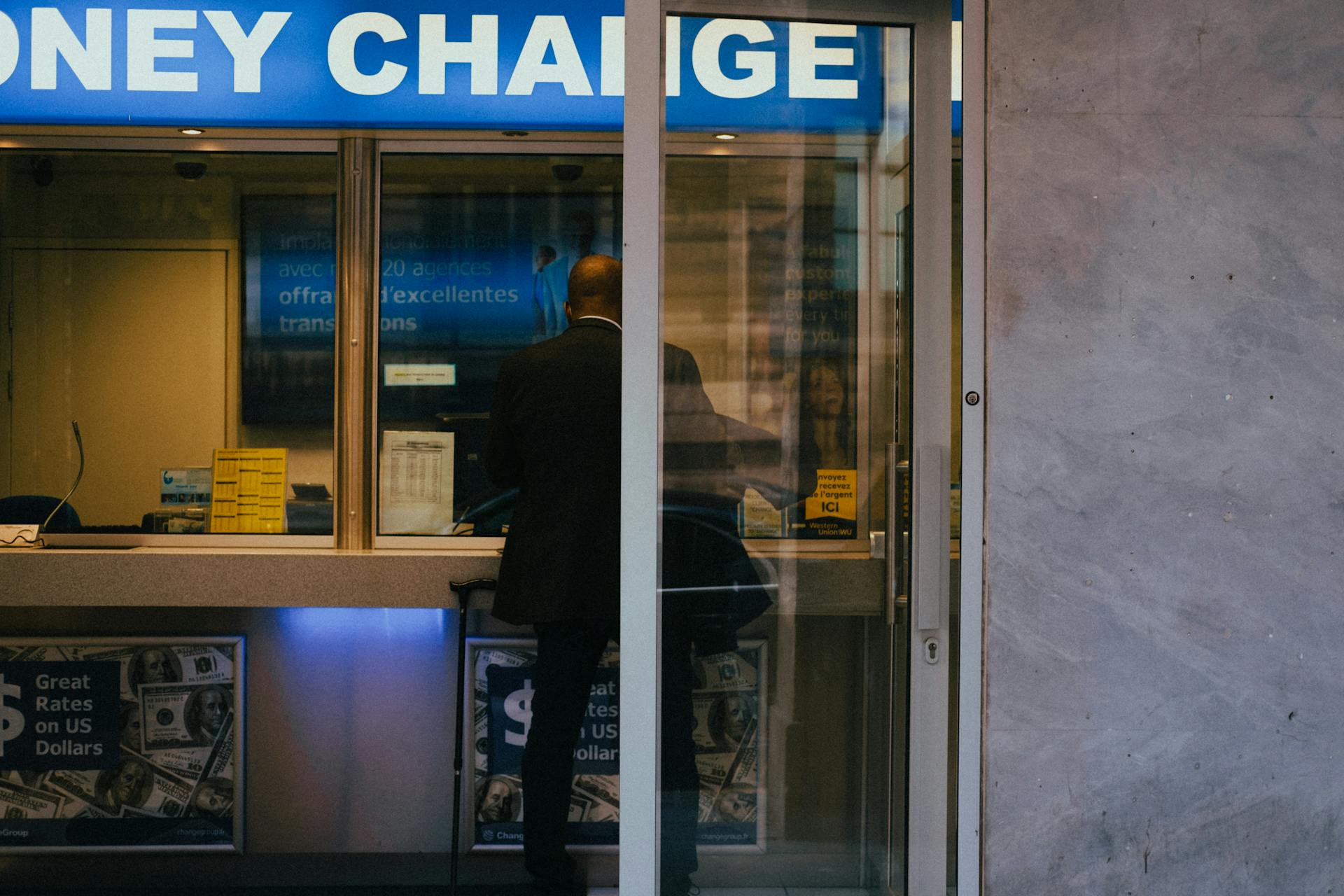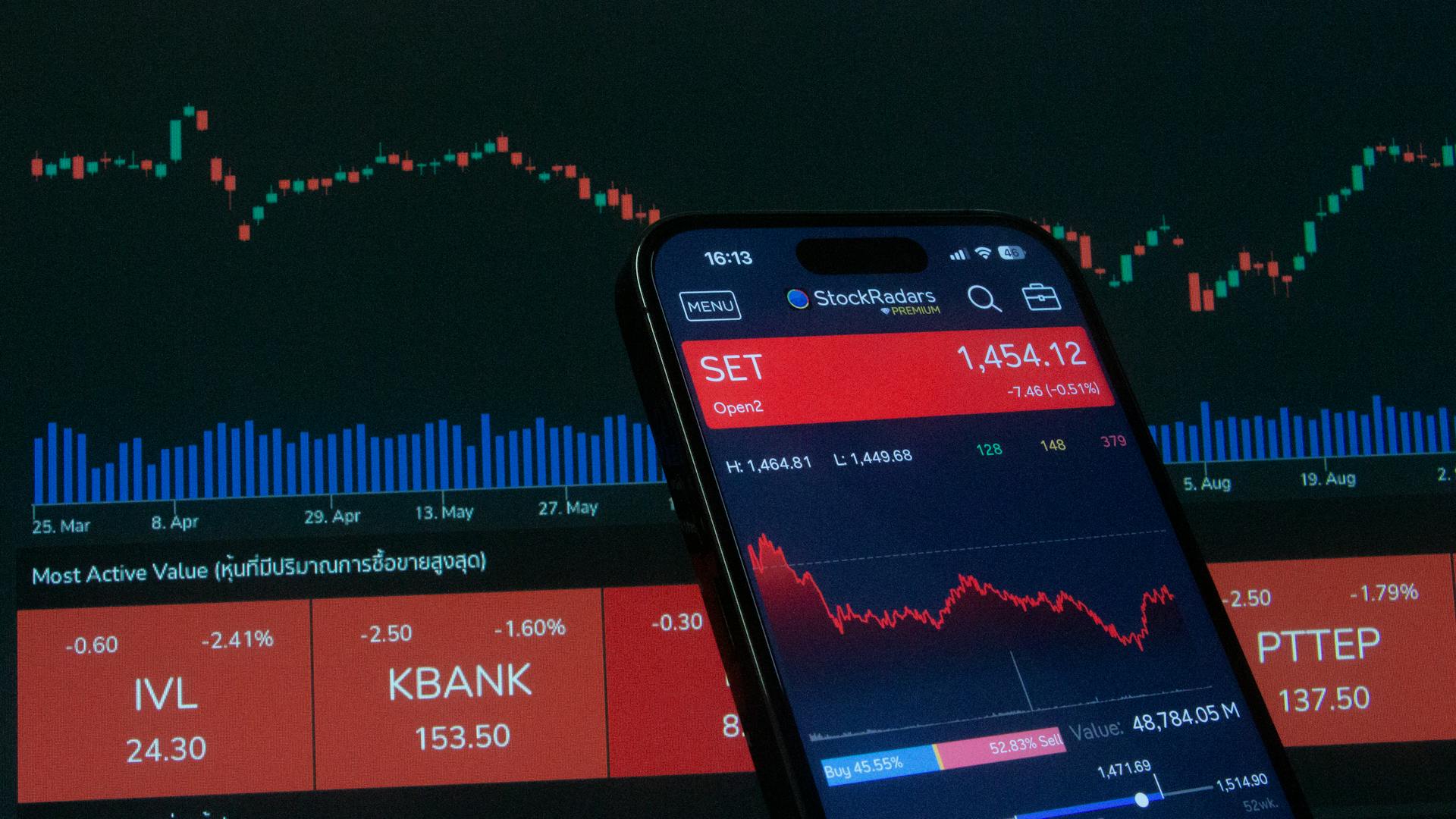
Libor, the London Interbank Offered Rate, has been the primary benchmark for short-term interest rates for decades. However, its reliability has been compromised due to the 2008 financial crisis.
The Alternative Reference Rates Committee (ARRC) was established in 2014 to identify alternative reference rates in the US. The ARRC recommended the Secured Overnight Financing Rate (SOFR) as a replacement for Libor.
SOFR is based on actual transactions in the US Treasury market, making it a more accurate and reliable benchmark. It is also more transparent than Libor, as it is derived from observable market data.
The use of SOFR is gaining traction in the financial industry, with many institutions already adopting it as a reference rate in their financial instruments.
Check this out: Coupon Rate vs Market Rate
Global Context
The global financial landscape is undergoing a significant shift as markets transition to alternative reference rates. This change is being driven by regulators who are urging markets participants to adopt new benchmarks.
LIBOR, which was a cornerstone of the financial system, is being wound down. Hundreds of trillions of dollars' worth of financial products were underpinned by LIBOR, making its replacement a complex task.
Regulators, including the Financial Stability Board and the International Organization of Securities Commissions, have emphasized the need for benchmarks to be based on overnight reference rates derived from transactions. This has led to the development of alternative reference rates.
The industry has responded by adopting a range of alternative reference rates, including the AONIA and SARON. These rates aim to provide a more stable and reliable basis for financial transactions.
U.K. and Europe
The U.K. and Europe have been actively transitioning to alternative reference rates, with significant changes taking place in 2021. The FCA confirmed that most GBP LIBOR settings would cease to be published beyond the year end.
In the U.K., the Sterling Overnight Interbank Average (SONIA) was chosen as the preferred alternative reference rate. SONIA has been a benchmark since 1997, reflecting the average interest rates that banks pay to transact sterling overnight from other financial institutions.
The Bank of England became SONIA’s administrator in 2016 and implemented reforms to strengthen its methodology. This involved broadening SONIA’s scope of overnight unsecured deposits to help bolster underlying transaction volumes.
In Europe, the ICE Euribor contract references the EMMI Euribor rate, which has seen recent reform and has been deemed representative. EURIBOR futures will continue to trade as they do currently.
The FCA announced in March 2021 that the CHF LIBOR rate would cease to be published beyond the year end, leading to the introduction of SARON futures in January 2021. SARON is a transaction-based benchmark representing the overnight interest rate of the secured money market for Swiss francs (CHF).
For your interest: SONIA (interest Rate)
U.K. - Sonia
The U.K. has a new benchmark rate, SONIA, which stands for Sterling Overnight Interbank Average. It was chosen by the Working Group on Sterling Risk-Free Reference Rates as the U.K.'s preferred alternative reference rate.
SONIA has been a benchmark since 1997 and reflects the average interest rates that banks pay to transact sterling overnight from other financial institutions. This is a transaction-based benchmark, which is different from other types of benchmarks.

The Bank of England became SONIA's administrator in 2016 and implemented reforms to strengthen its methodology. These reforms involved broadening SONIA's scope of overnight unsecured deposits to help bolster underlying transaction volumes.
In 2017 and 2018, ICE listed their first futures contracts referencing SONIA, with the offering increasing to also include a full suite of Options in 2020. Volume and open interest built steadily from launch.
By December 2021, ICE converted all outstanding open interest in Short Sterling Futures and Options to their equivalent SONIA derivatives, without issue. Now, ICE SONIA Futures are the dominant GBP STIRS contract.
Europe - Euribor
Euribor has seen recent reform and has been deemed representative, with no confirmed plans from regulators to seek an alternative rate. Euribor futures will continue to trade as they do currently.
The FCA announced in March 2021 that the CHF LIBOR rate would cease to be published beyond the year end.
The ICE Euribor contract references the EMMI Euribor rate, not a EUR LIBOR rate.
You might enjoy: Prime Rate versus Libor
U.S. and Alternative Reference Rates
The U.S. has been working to transition away from the London Interbank Offered Rate (LIBOR) since 2014, when the Alternative Reference Rates Committee (ARRC) was established.
The ARRC, consisting of private-sector members and governmental entities, recommended the adoption of the secured overnight financing rate (SOFR) as the preferred alternative reference rate.
SOFR is an overnight reference rate that measures the cost of borrowing cash with U.S. Treasuries as collateral and is published daily by the New York Fed based on data collected on over $USD800 billion in secured overnight repurchase transactions.
The SOFR rate is considered more stable and less prone to manipulation than LIBOR, which relied on estimates and had a thin and declining base of transactions.
In 2018, the ARRC published a timeline for making the transition from LIBOR to SOFR, with a complete phase out of LIBOR by Dec. 31, 2021, and the remaining rates by June 2023.
The New York Fed publishes the latest SOFR on its website each business day at 8 a.m., including the overnight rate and three compounded averages of the SOFR with tenors of 30, 90, and 180 days.
Expand your knowledge: What Does the Fed Rate Cut Mean for Mortgage Rates
Background
The LIBOR, or London Interbank Offered Rate, is a widely used short-term interest rate benchmark in the U.S. financial system. It's referenced in various contracts, including mortgages, student loans, and other consumer lending instruments.
The LIBOR has been around for a while, but in July 2017, the U.K. Financial Conduct Authority announced it would stop requiring banks to submit data necessary to calculate LIBOR rates after December 31, 2021. This marked the beginning of a transition away from LIBOR.
In 2017, the Alternative Reference Rates Committee (ARRC) recommended the adoption of the Secured Overnight Financing Rate (SOFR) in place of LIBOR. SOFR is based on the rate that financial institutions pay each other to borrow cash overnight in transactions collateralized by U.S. Treasury securities.
A complete phase-out of LIBOR was called for by the ARRC's timeline, with a deadline of December 31, 2021. As SOFR was being adopted, LIBOR was gradually winding down. The ICE Benchmark Administration, which oversees LIBOR, announced that it would stop publishing most LIBOR rates as of December 31, 2021, and the remaining ones by June 2023.
The NCUA, or National Credit Union Administration, advises federally insured credit unions to stop entering new contracts that use LIBOR as a reference rate as soon as possible. New contracts should use a reference rate other than LIBOR or have robust fallback language that includes a clearly defined alternative reference rate.
Investments
As of December 31, 2020, the GSEs stopped issuing new LIBOR-indexed securities.
Fortunately, the legacy LIBOR-indexed securities remain a significant percentage of variable rate assets held by credit unions.
These securities have bond trustees that represent investors who are responsible for implementing robust fallback language to a new reference rate or rates in the transition away from LIBOR.
The transition to a new reference rate will require broad acceptance by the financial markets, which is key to a smooth and fast transition.
The OFR is involved in the planning for the alternative reference rate and is playing a role in its implementation.
In the United States, the Federal Reserve Board and the New York Fed established the Alternative Reference Rates Committee (ARRC) to recommend and help implement a new benchmark to supplant the LIBOR.
The ARRC currently consists of private-sector members, including major financial institutions such as Bank of America, Goldman Sachs, JPMorgan Chase, and Wells Fargo.
The SOFR, or Secured Overnight Financing Rate, is one of the new rates recommended by the ARRC, and it's based on repo interest rates.
The SOFR will include overnight, Treasury-backed repo transactions that take place in the Bank of New York Mellon’s triparty repo system or are cleared through one of two Fixed Income Clearing Corporation platforms.
Curious to learn more? Check out: Beal Bank Credit Rating
U.S. - S
The Secured Overnight Financing Rate (SOFR) has been recommended by the Alternative Reference Rates Committee (ARRC) as the preferred alternative reference rate to USD LIBOR. SOFR is an overnight reference rate that broadly measures the cost of borrowing cash with U.S. Treasuries as collateral.
Additional reading: Credit Reference Agency
SOFR is published daily by the New York Fed based on data collected on over $USD800 billion in secured overnight repurchase transactions. These transactions represent the largest underlying volumes of any U.S. money market, underscoring SOFR’s stability.
The SOFR rate is based on repo interest rates, which are secured loans where one party sells a security to another party and agrees to repurchase it later at a set date and price. SOFR is a broad Treasuries repurchase financing rate and has been produced by the Federal Reserve Bank of New York on a daily basis since the second quarter of 2018.
SOFR is a secured rate and does not have a credit risk element. This makes it a more stable and reliable alternative to LIBOR, which often relied on estimates. SOFR is also based on a much greater transaction volume than LIBOR, making it more robust.
The SOFR is used by lenders to set interest rates for commercial and consumer loans. For an adjustable-rate mortgage (ARM), for example, the lender will take the current SOFR and add a margin in the form of additional percentage points to set the ARM's interest rate.
Curious to learn more? Check out: Arm Mortgage Rates
Here is a breakdown of how SOFR is used:
- Overnight SOFR: The overnight rate is published daily by the New York Fed.
- Compounded averages: The New York Fed publishes three compounded averages of the SOFR, with tenors of 30, 90, and 180 days.
- SOFR index: The New York Fed also publishes an SOFR index that can calculate compounded average rates over other time periods.
The transition to SOFR is expected to be completed by June 2023, with most LIBOR settings ceasing by the end of 2021. This will require broad acceptance by the financial markets, and collaboration between industry and government will be key to a smooth and fast transition.
Real Estate Loans
The secured overnight financing rate (SOFR) has become a widely used reference rate for commercial and consumer loans, including adjustable-rate mortgages (ARMs).
Credit unions can originate ARMs using loan underwriting standards established by government-sponsored enterprises (GSEs) like Fannie Mae or Freddie Mac.
Fannie Mae and Freddie Mac stopped acquiring single-family and multifamily LIBOR ARMs on December 31, 2020.
ARMs that conform to GSE underwriting standards represent low LIBOR transition risk exposure.
Credit unions that originate non-conforming or customized ARMs need to ensure they have robust fallback language in case the variable rate index is no longer available.
Examiners will determine if an ARM has robust fallback language in the event the variable rate index is no longer available.
Readers also liked: What Is a Variable Rate Heloc
F. Oversight
Credit unions are expected to provide regular status updates to senior management and the board on their transition plans.
A credit union should provide its transition plan to the personnel necessary to implement the transition.
Examiners will review management's plan to determine if a credit union can identify and understand its LIBOR exposures.
Examiners should discuss LIBOR exposures with management and evaluate whether the credit union has an established plan to transition away from entering into any new LIBOR-based financial contracts before December 31, 2021.
This will ensure that any exposures to the respective LIBOR setting discontinuance dates are identified and managed.
Frequently Asked Questions
What is obfr vs effr?
The EFFR and OBFR are two interest rates calculated from data on bank transactions, with the main difference being that the OBFR includes Eurodollar transactions and certain domestic deposits. Understanding the distinction between these two rates can provide valuable insights into the US financial system.
Sources
- https://www.ice.com/insights/market-pulse/alternative-reference-rates
- https://www.investopedia.com/alternative-reference-rates-committee-arrc-definition-5225398
- https://www.weinsteinspira.com/reference-rate-reform-what-you-need-know/
- https://ncua.gov/regulation-supervision/letters-credit-unions-other-guidance/evaluating-libor-transition-plans
- https://www.financialresearch.gov/data/libor-alternatives/
Featured Images: pexels.com


